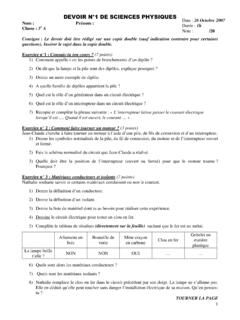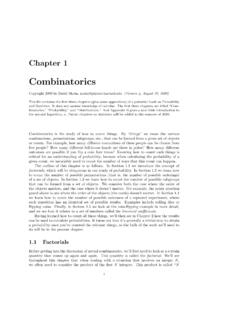Transcription of Kinematics in 2-D (and 3-D) - Harvard University
1 Chapter 3 Kinematics in 2-D (and 3-D)FromProblems and Solutions in Introductory Mechanics(Draft version, August 2014)David Morin, IntroductionIn this chapter, as in the previous chapter, we won t be concerned with the actual forces thatcause an object to move the way it is moving. We will simply take the motion as given, andour goal will be to relate positions, velocities, and accelerations as functions of time. However,since we are now dealing with more general motion in two and three dimensions, we will giveone brief mention of forces:Motion in more than one dimensionNewton s second law (for objects with constant mass) isF=ma, wherea dv/dt.
2 This law(which is the topic of Chapter 4) is avectorequation. (See Appendix A in Section for areview of vectors.) So it really stands for three different equations:Fx=max,Fy=may, andFz=maz. In many cases, these three equations are decoupled, that is, thexequation hasnothing to do with what is going on in theyandzequations, etc. In such cases, we simply havethree copies of 1-D motion (or two copies if we re dealing with only two dimensions). So wejust need to solve for the threeindependentmotions along the three coordinate motionThe classic example of independent motions along different axes is projectile motion.
3 Projectilemotion is the combination of two separate linear motions. The horizontal motion doesn t affectthe vertical motion, and vice versa. Since there is no acceleration in the horizontal direction(ignoring air resistance), the projectile moves with constant velocity in thexdirection. Andsince there is an acceleration of gin the vertical direction, we can simply copy the results fromthe previous chapter (in particular, Eq. ( ) withay= g) for the motion in therefore see that if the initial position is(X,Y)and the initial velocity is(Vx,Vy), then theacceleration componentsax=0 anday= g( )lead to velocity componentsvx(t)=Vxandvy(t)=Vy gt( )and position componentsx(t)=X+Vxtandy(t)=Y+Vyt 12gt2.
4 ( )Projectile motion is completely described by these equations for the velocity and position INTRODUCTION43 Standard projectile resultsThe initial velocityVof a projectile is often described in terms of the initial speedv0(we ll use alowercasevhere, since it looks a little nicer) and the launch angle with respect to the Fig. , the initial velocity components are thenVx=v0cos andVy=v0sin , so thev0 cos v0 v0 sin components in Eq. ( ) becomevx(t)=v0cos andvy(t)=v0sin gt,( )and the positions in Eq. ( ) become (assuming that the projectile is fired from the origin, sothat(X,Y)=(0,0))x(t)=(v0cos )tandy(t)=(v0sin )t 12gt2.
5 ( )A few results that follow from these expressions are that the time to the maximum height, themaximum height attained, and the total horizontal distance traveled are given by (see Prob-lem )ttop=v0sin g,ymax=v20sin2 2g,xmax=2v20sin cos g=v20sin 2 g.( )The last of these results holds only if the ground is level (more precisely, if the projectile returnsto the height from which it was fired). As usual, we are ignoring air along a planeIf an object slides down a frictionless plane inclined at angle , the acceleration down the plane isgsin , because the component ofg(the downward acceleration due to gravity) that points alongthe plane isgsin ; see Fig.
6 (There is no acceleration perpendicular to the plane because gg cos g sin g sin normal force from the plane cancels the component of the gravitational force perpendicularto the plane. We ll discuss forces in Chapter 4.) Even though the motion appears to take placein 2-D, we really just have a (tilted) 1-D setup. We effectively have freefall motion along thetilted axis, with the acceleration due to gravity beinggsin instead ofg. If =0, then thegsin acceleration along the plane equals 0, and if =90 it equalsg(downward), as generally, if a projectile flies through the air above an inclined plane, the object s accel-eration (which is the downward-pointing vectorg) can be viewed as the sum of its componentsalong any choice of axes, in particular thegsin acceleration along the plane and thegcos acceleration perpendicular to the plane.
7 This way of looking at the downwardgvector can bevery helpful when solving projectile problems involving inclined planes. See Section inAppendix A for further discussion of vector motionAnother type of 2-D motion is circular motion. If an object is moving in a circle of radiusrwithspeedvat a given instant, then the (inward) radial component of the acceleration vectoraequals(see Problem (a))ar=v2r.( )This radially inward acceleration is called thecentripetalacceleration. If additionally the objectis speeding up or slowing down as it moves around the circle, then there is also a tangentialcomponent ofagiven by (see Problem (b))at=dvdt.
8 ( )This tangential component is the more intuitive of the two components of the acceleration; itcomes from the change in the speedv, just as in the simple case of 1-D motion. Thearcomponent44 CHAPTER 3. Kinematics IN 2-D (AND 3-D)is the less intuitive one; it comes from the change in thedirectionofv. Remember that theaccelerationa dv/dtinvolves the rate of change of the entire vectorv, not just the magnitudev |v|. A vector can change because its magnitude changes or because its direction changes (orboth). The former change is associated withat, while the latter is associated is sometimes convenient to work with theangular frequency (also often called thean-gular speedorangular velocity), which is defined to be the rate at which the angle around thecircle (measured in radians) is swept out.
9 That is, d /dt. If we multiply both sides of thisequation by the radiusr, we obtainr =d(r )/dt. Butr is simply the distancestraveled alongthe circle,1so the right-hand side of this equation isds/dt, which is just the tangential =v= =v/r. In terms of , the radial acceleration can be written asar=v2r=(r )2r= 2r.( )Similarly, we can define theangular accelerationas d /dt d2 /dt2. If we multiplythrough byr, we obtainr =d(r )/dt. But from the preceding paragraph,r is the tangentialspeedv. Therefore,r =dv/dt. And since the right-hand side of this equation is just thetangential acceleration, we haveat=r .( )We can summarize most of the results in the previous two paragraphs by saying that the linear quantities (distances, speedv, tangential accelerationat) are related to the angularquantities (angle , angular speed , angular acceleration ) by a factor ofr:s=r ,v=r ,at=r.
10 ( )However, the radial accelerationardoesn t fit into this Multiple-choice bullet is fired horizontally from a gun, and another bullet is simultaneously dropped fromthe same height. Which bullet hits the ground first? (Ignore air resistance, the curvatureof the earth, etc.)(a)the fired bullet(b)the dropped bullet(c)They hit the ground at the same projectile is fired at an angle with respect to level ground. Is there a point in the motionwhere the velocity is perpendicular to the acceleration? projectile is fired at an angle with respect to level ground. Does there exist a suchthat the maximum height attained equals the total horizontal distance traveled?















